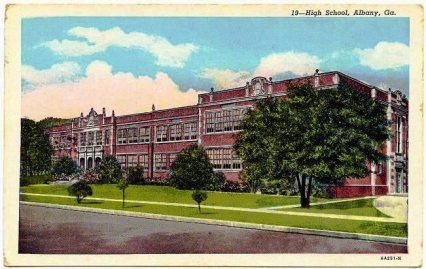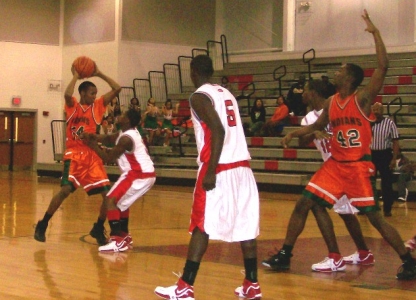Reclassification is months away in the Georgia High School Association, but guesses about which schools are the biggest in the state are probably fairly easy ones.
The largest will come from Gwinnett County, some just slightly smaller from Cobb County. Lowndes may push into the state’s top 10.
Collins Hill dropped jaws and raised eyebrows when it topped 4,000 students almost 15 years ago. A high school larger than the populations of some small towns, including county seats.
It may not have been the first high school in Georgia to reach that mark.
Georgia’s average daily attendance figures for schools are difficult to find prior to the late 1970s.
I have stumbled on a partial list from 1951 and have a full list from The Atlanta Constitution from 1965. I lack access to ProQuest’s Constitution archives to see if more exist.
There are three lists that popped up – 1961-62, 1967-68 and 1969-70 – labeled Public High School Data in the Georgia Government Publications archives. The box of Georgia Interscholastic Association archives housed by the Georgia High School Association has a handful of region lists with ADA numbers.
Finally, some school systems would give attendance reports at the beginning of school years. Most of those that have surfaced are from smaller systems.
Mega-sized schools were few and far between in the olden days, at least by current standards.
The Atlanta Daily World in 1936 did claim that Atlanta’s Washington High was housing nearly 4,000 students. What grades Washington taught was not mentioned. Washington was the city’s sole public black high school.
Few others would have held as many as 1,500.
A few numbers that have surfaced from before the 1960s are eye-catching.
Augusta’s Richmond Academy had 989 students at the start of the 1940-41 school year while all-girls high school Tubman enrolled 1,118. In 1952-53, The Augusta Chronicle reported that at the start of the fall term Richmond Academy (and the associated junior college) had 1,500 students. Tubman had 1,262.
Lucy Laney had 904 students in high school in October 1952. At the time, it was Augusta’s only public black high school.
Lanier was a 2,000-man school for 1952-54 reclassification, according to numbers published in The Daily Tifton Gazette. It and A.L. Miller, boys and girls high schools, respectively, were probably similarly-sized. At that time, they were the only public white high schools in Bibb County.
Soon, more cumulative lists were published. These were the largest high schools in each, with a few historical notes:
1959-60 (GIA archives)
- Washington, Atlanta (1,534)
- Howard, Atlanta (1,188)
- Spencer (1,164)
- Ballard-Hudson (1,104)
- Beach (1,082)
Desegregation began in 1961 and Atlanta kept opening majority black high schools in the city, but Washington consistently grew through the decade. Howard grew slightly, but by 1969-70 was falling, with an average daily attendance recorded at 858 that year. In 1976, the Atlanta school system closed Howard High. Washington lost numbers in the 1970s, but never dropped below Class AA.
1961-62 (Public High School Data, includes white and black schools)
- Savannah (2,008)
- Washington, Atlanta (1,777)
- Albany (1,697)
- Baker (1,605)
- Columbus (1,581)
Albany High was not at its largest in 1961-62 – it was listed at 1,824 students in 1967-68’s Public High School Data – but the school was arguably at its most powerful. Albany was the sole white high school in the city (Monroe was the only black high school) and with no big private schools to eat at its population.
In 1963, the Dougherty school district opened Dougherty High on the east side of town. As the city’s population shifted, Westover opened in 1968 on the northwest side. With Deerfield Academy opening, then Riverview Academy opening and white flight taking hold, Albany’s significance began to dwindle. Albany’s ADA was 830 in 1969-70. While stable, it ultimately wound up on the chopping block in 2017. Dougherty’s oldest high school is no more.
1966-68 (Atlanta Constitution list for GHSA reclassification from Nov. 18, 1965)
- Lanier (3,126)
- A.L. Miller (2,994)
- Arnold (2,761)*
- Jordan (2,512)
- Baker (2,445)
Lanier and Miller would both lose significant numbers with the creation of Mark Smith and Lasseter high schools. All three Macon girls’ high schools were GHSA members, but oddly only Miller was listed in reclassification. A.L. Miller, Lasseter and McEvoy, the latter being the other Macon girls’ high school, were only associate members of the GHSA.
While the classifications list was released in November 1965, Baker’s and Jordan’s attendance figures might have been estimated (or simply incorrect as they vary tremendously from the state-published Public High School Data figures from 1961-62). The Constitution does list the region’s newest school, Hardaway, as having 1,448 students. Baker remained one of the state’s largest high schools as of the 1967-68 Public High School Data, but its number had dropped by 600 students. Jordan was even harder hit, losing around 800 in average daily attendance.
Long associated with Columbus’ military community, Baker’s decline was steep. The GHSA’s average daily attendance was 934 when it began publishing average daily attendance data in its handbooks for 1978-79 region listings. In 1980, the number was 607 before falling all the way to 363 in 1986-87. It recovered to 600 in 1990-91, but by then it was too late; Baker closed in 1991.
* Arnold is almost assuredly an incorrectly labeled Savannah in the reclassification region list. Though the new Windsor Forest possibly pulled from its attendance area, Public High School Data of 1967-68 lists Arnold’s average daily attendance figure as 397, with Windsor Forest at 605.
Savannah is not listed in region list (the listing is technically “Savannah Arnold” in The Constitution) and at that time, Savannah’s numbers were huge. The GHSA region list of 1966-67 has both schools in the same conference.
1966-68 (GIA archives)
- Ballard-Hudson (1,862)
- Spencer (1,353)
- Monroe, Albany (1,138)
- Carver, Columbus (1,098)
- Tompkins (1,066)
Note: Likely constructed during the summer of 1966, after several teams jumped to the GHSA, the ADA list did not include schools such as Washington of Atlanta, which would have been around 2,000 students. It does, however, include several Savannah schools that jumped that year.
1967-68 (Public High School Data)
- Washington, Atlanta (2,039)
- Savannah (2,017)
- Albany (1,824)
- Baker (1,811)
- Price (1,716)
Albany peaks in (known) attendance. Price had 500 students fewer in the 1969-70 Public High School Data. Savannah began to slide, too, in 1969-70.
1968-70 (GIA archives)
- Ballard-Hudson (1,559)
- Monroe (1,142)
- Central, Newnan (763)
- T.J. Elder (711)
- Fairmont (692)
The exodus had begun, in both terms of larger schools to the GHSA and integration, and by the time district play actually commenced in 1968, Ballard-Hudson was gone to the GHSA as well. When fully integrated, Washington County – with whom Elder combined – would never be higher than a Class AAA school. Fairmont’s enrollment, however, would push Griffin to being one of the state’s largest high schools.
1969-70 (Public High School Data)
- Washington, Atlanta (1,919)
- Baker (1,918)
- Warner Robins (1,815)
- Savannah (1,797)
- Jordan (1,762)
Warner Robins’ ascent was rapid. After opening in 1944 – high school students were sent to Bonaire when the base first opened – its growth was enough to warrant a second high school (Northside) in 1963. In 1961-62, Warner Robins High had 1,286 students. In 1969-70, the Warner Robins and Northside accounted for nearly 3,200 students.
To be continued in part II, where we jump ahead to the end of the 1970s and see the rise of much larger metro Atlanta schools.
Sources: Atlanta Daily World – Sept. 15, 1936; The Daily Tifton Gazette – Oct. 24, 1951; The Augusta Chronicle – Sept. 8, 1940, Oct. 8, 1952; The Atlanta Constitution – Nov. 18, 1965.







